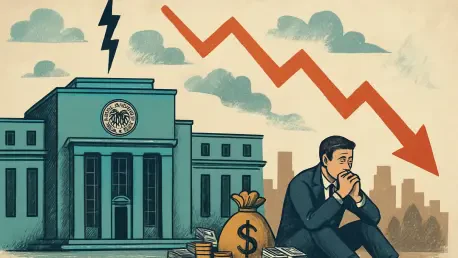Imagine a scenario where the Federal Reserve, the bedrock of U.S. monetary policy, faces direct political interference, shaking the confidence of global markets overnight. This isn’t a hypothetical—it’s the reality unfolding as President Donald Trump attempts to remove Fed Governor Lisa Cook, alleging pre-office mortgage fraud. The U.S. Supreme Court’s decision to hear arguments on this unprecedented move has thrust financial markets into uncertainty, with potential implications for interest rates, investor sentiment, and economic stability. This analysis dives into the market dynamics surrounding this historic clash, examining how a challenge to Fed independence could reshape economic governance. By exploring current trends, data, and projections, the goal is to provide clarity on what this power struggle means for businesses, investors, and policymakers navigating an already volatile landscape.
Market Trends and Economic Analysis
Immediate Reactions: Volatility in Financial Markets
The announcement of Trump’s bid to fire Lisa Cook has already sparked ripples across financial markets, with early indicators showing heightened volatility in key indices. Stock markets, particularly sectors sensitive to interest rate changes like banking and real estate, have exhibited erratic swings as investors grapple with the possibility of a politically influenced Fed. Bond yields, often a barometer of market confidence in monetary policy, have fluctuated, reflecting uncertainty over whether the Fed’s ability to act independently on inflation and growth targets might be compromised. Data from major exchanges suggests a cautious approach among traders, with increased hedging activities as they brace for potential outcomes of the Supreme Court ruling expected in the coming months.
This immediate market reaction underscores a broader concern: the erosion of trust in the Fed as a nonpartisan entity. Historically, the Fed’s autonomy has been a stabilizing force, allowing it to make tough calls—such as rate hikes to tame inflation—without fear of political backlash. If presidential power extends to removing governors at will, market participants fear a future where monetary policy could be swayed by short-term political agendas, leading to unpredictable economic cycles. This nervousness is evident in the uptick of safe-haven asset purchases, signaling a defensive posture among institutional investors.
Sector-Specific Impacts: Banking and Beyond
Drilling deeper into sector-specific trends, the banking industry stands at the forefront of potential disruption. Banks rely heavily on Fed policies for lending rates and liquidity provisions, and any hint of political interference could alter their risk models significantly. Analysts note a growing wariness among financial institutions, with some already adjusting forecasts for loan growth under scenarios where Fed decisions might prioritize electoral cycles over economic fundamentals. This could lead to tighter credit conditions, impacting small businesses and consumers reliant on borrowing.
Beyond banking, export-driven sectors like manufacturing face indirect risks tied to currency valuation. The U.S. dollar’s strength, often bolstered by confidence in an independent Fed, could waver if global investors perceive heightened political risk in American economic policy. Emerging data shows foreign investment in U.S. Treasuries dipping slightly, a trend that could accelerate if the Supreme Court ruling favors expanded presidential control. Such shifts would ripple through trade balances, potentially increasing costs for imported goods and squeezing margins for multinational corporations operating in the U.S.
Broader Economic Indicators: Inflation and Growth Projections
Turning to macroeconomic indicators, the specter of a less independent Fed raises critical questions about inflation and growth trajectories. Current projections from leading economic think tanks suggest that inflation, already a persistent concern, could become more volatile if monetary policy decisions are perceived as politically motivated. The Fed’s recent moves toward rate cuts, supported by Governor Cook, aim to balance growth with price stability, but market analysts warn that inconsistent policy signals could undermine these efforts, pushing consumer prices higher.
Growth projections also hang in the balance, with uncertainty over Fed autonomy contributing to downward revisions in GDP forecasts for the next two years. Businesses may delay capital investments amid fears of erratic interest rate policies, while consumer confidence could falter if economic stability appears at risk. Historical data reinforces this caution—periods of perceived political pressure on central banks globally have often correlated with reduced economic output and stalled recovery efforts. The current situation, while unique in its specifics, aligns with these broader patterns, signaling potential headwinds for sustained growth.
Long-Term Market Projections
Scenarios for Fed Independence: Best and Worst Cases
Looking ahead, market projections hinge on two primary outcomes of the Supreme Court’s ruling. In a best-case scenario, a decision upholding Fed independence by rejecting Trump’s removal of Cook could restore market confidence, stabilizing equity valuations and reinforcing the dollar’s global standing. This outcome would likely support a gradual return to predictable monetary policy, with interest rate adjustments based on data-driven assessments rather than political whims. Analysts anticipate a rally in risk assets under this scenario, particularly in growth-oriented sectors like technology, as certainty returns to economic planning.
Conversely, a ruling favoring presidential authority to remove Fed governors could usher in a worst-case scenario of prolonged market turbulence. Such a decision might embolden future administrations to influence monetary policy directly, potentially leading to inflationary spikes or premature rate changes aimed at short-term political gains. Projections under this outcome suggest a bearish trend for U.S. equities, with international investors possibly redirecting capital to markets with more stable central banking frameworks. The long-term cost to economic credibility could be steep, with diminished trust in U.S. financial systems affecting everything from foreign direct investment to borrowing costs.
Global Implications: A Domino Effect on International Markets
On a global scale, the implications of this case extend far beyond domestic markets, potentially triggering a domino effect across international financial systems. The U.S. Fed’s policies often set the tone for global monetary trends, influencing central banks from Europe to Asia. A perceived loss of independence could prompt other nations to reassess their own exposure to U.S. economic volatility, possibly accelerating de-dollarization efforts in trade and reserve holdings. Emerging market economies, particularly those with significant U.S. debt holdings, might face heightened currency risks as confidence in American economic stewardship wanes.
Furthermore, projections indicate that global commodity markets, including oil and gold, could see increased price volatility as investors seek alternative stores of value amid uncertainty. Multilateral institutions may also face pressure to mediate or provide guidance if U.S. monetary policy instability disrupts international trade agreements or debt repayment schedules. The interconnected nature of modern economies means that a single ruling on Fed autonomy could reshape capital flows worldwide, underscoring the high stakes of this legal battle for global market participants.
Reflecting on the Past: Strategic Lessons and Future Paths
Looking back, the intense market scrutiny surrounding Trump’s attempt to remove Fed Governor Lisa Cook revealed the fragility of trust in institutional independence, with financial sectors from banking to manufacturing bracing for potential fallout. The volatility in equity and bond markets, coupled with cautious adjustments in economic forecasts, painted a picture of an economy on edge, awaiting a landmark Supreme Court decision. These reactions highlighted how deeply embedded the principle of Fed autonomy is in sustaining market stability, as even the threat of political interference sent shockwaves through investor confidence.
Moving forward, strategic lessons emerged for stakeholders across the spectrum. Policymakers were urged to push for clearer legislative definitions of removal criteria for Fed governors, closing loopholes that could invite future disputes. Investors adapted by diversifying portfolios to mitigate risks tied to policy uncertainty, while businesses explored contingency plans for tighter credit or fluctuating currency values. The path ahead demanded vigilance—monitoring regulatory updates and engaging in scenario planning became essential to navigate potential shifts in economic governance. Ultimately, this episode served as a stark reminder that safeguarding central bank independence is not just a legal issue, but a cornerstone of enduring market resilience.









